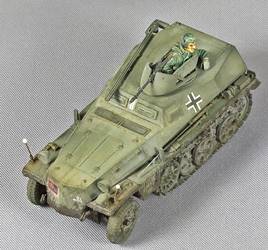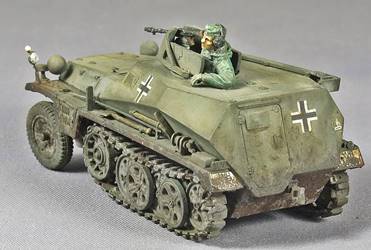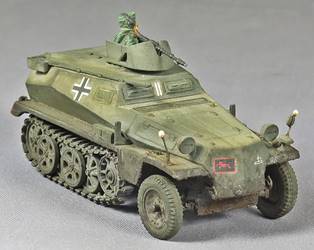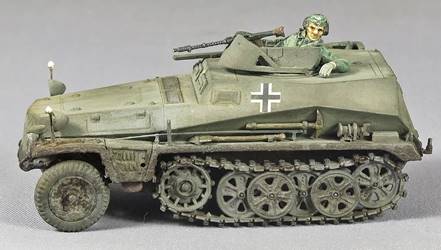|
History and version
The
Sd.Kfz.250 or leichter Schützenpanzerwagen (roughly translatable
as light rifleman armoured vehicle, where we can only assume that
the "light" referred to the "vehicle" and not
to the "rifleman") first appeared in prototype form in the
spring of 1940 and was based on a shortened Sd.Kfz.10 chassis (by
removing one road wheel). Two other variants on the same shortened
chassis existed: the Sd.Kfz.252 le.gep.Mun.Trsp.kw. (ammo carrier)
and Sd.Kfz.253 le.gep.Beob.Kw. (observation vehicle). Around a 100
of the former were produced, while 250 Sd.Kfz.253 were accepted between
October 1940 and June 1941 [1]. Mass production of the Sd.Kfz.250
only started after the production run of the Sd.Kfz.252 and 253 had
finished.
A little known fact is that two slightly different versions of the
Sd.Kfz. 250 Ausf.A existed: one based on the design of the Sd.Kfz.253
(minus the roof), known as Sd.Kfz.250/Z, and one with a design that
was specific for the Sd.Kfz.250, known as Sd.Kfz.250E. While the difference
between both might seem superficial, close examination shows that
there was almost no part or angle left unaltered.
After November 1941 only the Sd.Kfz.250E was kept in production until
the arrival of the Ausf.B (or "Neu"), which had a completely
new body.
While
not directly applicable to the Sd.Kfz.253 reviewed here, the differences
between the Sd.Kfz.250 Ausf.A with 250/Z Aufbau and that with 250E
Aufbau are listed below.
| |
Sd.Kfz.
253 and Sd.Kfz. 250/Z
March 1940 - July 1941 |
Sd.Kfz.
250E (second version)
August
1941 - October 1943 |
| Visors |
Flat,
double slit. Those on the side are at the same height as those
at the front.
Visor in rear door. |
Domed,
single slit. Those on the side are lower than those at the front.
No visor in rear door. |
| Headlights |
On
the side of the nose armor |
In
front of the (shorter) fenders |
| Lift
hooks on superstructure |
Yes |
No |
| Driver's
front plate |
More
vertical |
More
sloped |
| Rear
plate |
Shorter
and more sloped |
Larger
and more vertical |
| Plug
on right rear superstructure |
Yes
for Sd.Kfz.250. The Sd.Kfz.253 had an antenna here. |
No |
| Fenders |
Plain.
Initially (March-April 1940) more square, later more rounded |
Beaded |
| Ventilation
for engine exhaust |
Holes
or slits |
Slits |
| Engine
deck |
Some
sources mention that it was in three parts. Photographic evidence
shows that it was in two parts in at least a subset of the production
batch. |
Two
parts |
| Licence
plate |
On
a plate below the nose, which is more to the rear and of different
design than that of the Sd.Kfz.250E |
Painted
on the nose |
| Tool
box |
Smaller
box between fenders and extra box on fender |
One,
bigger box |
| Turn
indicators |
Initially
(March-April 1940) on the upper hull, later on the front fenders,
but more to the rear compared to the Sd.Kfz.250E |
Slightly
more to the front |
| Width
indicators on fenders |
Initially
(March-April 1940) in sheet metal, later as rods. More to the
rear compared to the Sd.Kfz.250E |
On
the edges |
| Notek
on left fender |
On
the edge |
In
the middle |
| Starter
crank cap in nose plate |
Small
for vehicles produced in March-April 1940; later it was larger |
Larger |
The
kit
The kit
comes with two identical sprues, a small decal sheet and a small fret
of PE, sufficient for two vehicles.
_t.jpg) _t.jpg)
_t.jpg) _t.jpg)
_t.jpg) _t.jpg) _t.jpg)
Pictures of instructions, box, decals and PE
parts from Henk
of Holland website, used with permission. You get 6 front tow
hooks, while 4 are sufficient.
Casting
quality is very nice with crisp detail, no flash, but rather thick
sprue gates. The tracks are better than some we have had in the past
from S-Model, but some modelers might still want to create some open
areas between each track pad. Some modelers have already done
exactly that. While the running gear is a simple affair (and with
age, I've come to appreciate that), S-Model didn't need to have put
all their roadwheels at exactly the same angle, as they did with their
Kettenkrad, and as
a lot of other manufacturers giving "easy assembly" roadwheels
have done for that matter.
I initially
started building the kit, using just enough parts and work to be able
to give an assessment of the accuracy of the kit. Interior
detail is not included. As the circular hatch can be built in
an open position, you might want to add some scraps of plastic in
there, unless you fill up the hole with a crew figure. All the other
doors and hatches in the kit would need a fair amount of work to open
up.
The single
marking option is probably meant to represent the vehicle from 2 Pz.Div.
seen on page 29 in [10]. In which case it would need a cross and tactical
sign on the rear plate as well. As S-Model gives enough decals to
do that, this is not a problem.
Plenty of spare decals are given without instructions on how to use
them, but, sadly, licence plates are missing.
The DAK palm trees can be used, as a small number of Sd.Kfz.253 made
it to North Africa, including this example
fitted with a frame antenna.
Accuracy
Judging
from the activity on different fora, people are interested in learning
about the accuracy of this kit, so I did a quick staff check and built
the kit in a rather rudimentary fashion (i.e. not adding all the details
and not yet gluing or cleaning up all the parts). More points will
be addressed below.
Measurements
were made against plans in [1], noting that the 250/Z and 250E bodies
do not have the exact same dimensions. (The /Z was somewhat longer,
for instance.)
As there are no plans of the Sd.Kfz.253 in [1], I used those of the
Sd.Kfz.250/Z as a proxy, as apart from the roof and interior lay-out
both were identical.
| |
Kit
dimension (mm) |
Real
vehicle dimension (mm) based on [1] |
Scale |
Correct
dimension in 1/72 (mm) |
Overall
length (excluding tow hooks)
|
60.4 |
4599 |
1/76.1 |
63.87 |
| Overall
width |
26.15 |
1959 |
1/74.9 |
27.21 |
| Overall
body height |
21.71 |
1590 |
1/73.2 |
22.08 |
| Height
of rear hull plate (section containing door - measured parallel
to plate at the right side) |
12.7 |
853 |
1/67.2 |
11.85 |
| Width
of rear door |
7.4 |
527 |
1/71.3 |
7.33 |
| Height
of rear door |
11.76 |
868 |
1/73.8 |
12.06 |
| Length
engine deck (measured in the horizontal plane) |
25.6 |
1931 |
1/75.4 |
26.82 |
| Width
engine deck (at the nose) |
11.17 |
775 |
1/69.4 |
10.76 |
| Width
noseplate at widest point |
13.91 |
1027 |
1/73.8 |
14.27 |
| Length
fighting compartment |
28.14 |
2022 |
1/71.8 |
28.08 |
| Maximum
width roof fighting compartment |
22.4 |
1641 |
1/73.3 |
22.79 |
Diameter
front wheel |
11.25 |
888 |
1/78.9 |
12.33 |
| Diameter
roadwheel |
7.75 |
560 |
1/72.3 |
7.78 |
| Length
track |
38.4 |
2828 |
1/73.6 |
39.28 |
| Width
track |
3.3 |
240 |
1/72.7 |
3.33 |
Some
conclusions and observations:
- Regarding
the overall dimensions, the kit is closer to 1/75-76, and there
is probably little we can do about that. The engine deck, doesn't
taper enough, resulting in a wide nose at the top, but as the maximum
width of the nose plate is actually underscale, this gives a head
on view of the nose that is off. (The differences between the narrowest
point and the widest point being too small.)
- While
the tracks are roughly the correct width and length, they suffer
from the same problem as the MK72
offering of the Sd.Kfz.250 Ausf.A, although to a lesser extent:
the tracks extend too far to the rear of the body. In the MK72 kit
this was due to the tracks being too long, in this kit it is because
the body is too short. The first roadwheel might also be a bit too
close to the drive sprocket, which is also a problem in the MK72
kit.
On a positive note, the kit has the correct number of track pads
per side (38) and lacks the beaded edges on the fenders, as it should.
- The
scale difference in the rear plate can be solved more easily, by
just cutting the bottom of the plate to the right of the rear door.
- More
annoyingly, the front wheels are vastly underscale, and it shows.
For the record, Ace kit wheels are 12.0mm, Esci wheels 10.8mm, while
the wheels in the Modell Trans update set for the Esci kit are 11.5mm.
To add insult to injury, the hub detail of the front wheels is not
correct for the Sd.Kfz.250/252/253, being closer to that seen on
the Sd.Kfz.222. To solve the hub problem, wheels can be taken from
S-Model's Pak36, which comes with one
of the Kettenkrad kits and the Chenillette
UE with Pak 36 kit. Using the latter would be the preferred
option, as it doesn't need the wheels that come with the kit. Unfortunately,
this will not solve the diameter problem, as they are exactly the
same.
Note that S-Model reacted to this mistake and has given correct
wheels in later releases of this kit.
_t.jpg)
Pictures of the new release. I completely forgot where I got those.
- Another
avoidable mistake is found in the front visors. These are domed
in the kit, which is correct for the 250E, but not for the 250/Z.
Those in the 250/Z (and thus the Sd.Kfz.253) were flat with a double
slit. If you are wondering, those in the sides should be domed,
and they are.
Note that S-Model reacted to this mistake and has given correct
visors in later releases of this kit.
_t.jpg)
_t.jpg)
Pictures of the new release. I completely forgot
where I got those.
- The
Sd.Kfz.253 had a licence plate on a plate below the nose. Neither
the plate or decals for the licence plates are provided.
- A
small detail that needs to be added is a tube for the exhaust on
the left side, and a domed cylinder for the muffler underneath.
_t.jpg)
Front
wheel as supplied in the kit. Upper hull not glued in place.
_t.jpg)
Front
wheel from Chenillette UE used instead. Upper hull not glued in place.
_t.jpg)
Nose
plate damage due to glue working its way between the lower and upper
hull. Entirely my fault.
_t.jpg)
Upper
hull not glued in place.
Construction
About
ten years after initially reviewing this kit, I decided to build it,
based on a picture on page 50 in Part 1 of [2]. This picture represents
a vehicle from 191 Sturmabteilung in March 1941 in Bulgaria, with
a field modification consisting of an MG and armored shield.
I also decided not to fix all dimensional issues and details of the
kit, only the ones mentioned below.
The kit fits very
well, and one might argue that it fits too well, as the real specimen
had an armored body where the upper hull hung slightly over the edges
of the lower hull. As this would have been a pain to do, and as this
feature is only really visible under certain lighting conditions,
I let it be.
I did fix the slope of the lower rear plate, by cutting it loose and
sloping it more upwards. I also removed a sliver from the lower right
edge of the upper rear plate (next to the door).
Note that some vehicles had a step added to the rear plate, which
I didn't go for.
Most
of my time building this kit was spent on scratchbuilding somewhat
acceptable front visors, as my kit was from an early batch, before
S-Model fixed them. I am still not fully satisfied with the result,
but it will have to do. The tiny bolts around these visors were not
added.
Minor modifications
are as follows:
- I
replaced the front wheels with those from an S-Model Pak36
- I sanded down
the edges of the rear fenders to make them just a little more angular
- I
modified the mounts of the front headlights
- I scribed a
panel line on the engine deck, towards the front, even though I
am not sure if this vehicle had the three-part engine deck
- I
removed the lower plate that protects the front suspension. Pictures
show that many vehicles had these plates removed (lost ?), damaged
or replaced. It is this plate that would hold the front licence
plate, if one were included in the kit
- I added a small
tube for the exhaust on the left side, and a domed cylinder for
the muffler underneath.
- I glued the
individual outer roadwheels at slightly different angles to give
a more natural look. This means that the outer and inner parts of
these roadwheels are no longer aligned, but I considered that to
be the lesser evil.
- I only used
half of the PE part for the rear convoy light (PA3), as otherwise
there would be detail on both sides, which isn't correct.
- I
(unintentionally) broke the shovel when removing it from the sprue
and decided to replace it with one from the spares box.
- I lost the
small jack and ended up scratchbuilding a new one.
The last
modification I added was scratchbuilding the MG shield and adding
an MG from the spares box. Wanting to leave the hatches open, as they
have some nice detail on the inside, but not wanting to add detail
to the interior, I decided to add a figure to the hatch. The presence
of the MG and hatches created a headache as very few figures wanted
to fit, but I ended up with a figure and pose that looks quite attractive
to me.
Note that the circular hatch on top could rotate on the real vehicle.
This kit doesn't offer that option; modifying it yourself would be
a bit of a challenge.
Decals came from
the spares box, matching the one in the picture as closely as possible.
 
 
Comparison
with the MK72 Sd.Kfz.250 Ausf.A.
We previously
reviewed the MK72 offering
of the Sd.Kfz.250 Ausf.A, which represents the 250E body. That
kit is nicely detailed, but also has some scale issues. We already
mentioned some of them above. Comparison with this kit teaches us
that cross-kitting might be an option to arrive at a more correct
Sd.Kfz.250 or 253:
- The
tracks of the S-Model kit are closer to scale, and might fit on
the MK72 kit.
- The
front wheels of the MK72 kits are better, and might fit on the S-Model
kit.
- Other
exchanges might be possible, and we would be interested to hear
from our readers if someone attempts to cross-breed both kits.
Conclusion
This
could have been a show stopper, but there are some errors that might
easily have been avoided. On the other hand, apart from the front
wheels, rear end of the tracks and look of the nose plate, most scale
issues are not really noticeable to the naked eye. To S-Model's credit,
later releases of this kit included corrections regarding the front
visors and wheels.
This
kit would also be a good start to build a Sd.Kfz.250 with the earlier
body. One would "only" need to remove the roof and add interior.
For those
that like to stray from the beaten track, we gladly share the following
pictures. Inspiration might also be found here.
_t.jpg)
Sd.Kfz.250 Ausf. A (and 250Z Aufbau) with
Panzer I turret. Picture from EBay auction-used for discussion purposes.
.jpg)
Sd.Kfz.250 Ausf. A (or Sd.Kfz. 253 ?) with 250Z
Aufbau with a very peculiar position for a frame antenna. Picture
from EBay auction - used for discussion purposes.
References:
[1] Panzer
Tracts 15-1, leichter Schuetzenpanzerwagen (Sd.Kfz.250) Ausf. A &
B, T.L. Jentz & H.L. Doyle.
[2]
Sd.Kfz.250 Alt-Neu Archive Part 1 & 2, Total Detail, Martin Kögel.
[3] Sd.Kfz.250
Vol I & II, Wydawnictwo Militaria 173 & 231.
[4] Sd.Kfz.250-251
at War, Trojca, W. Trojca, K Münch.
[5] http://vincesgallery.smugmug.com/History/SdKfz-250-Alt
[6] Sd.Kfz.
250, Miltar's kits Hors série N°1, MK Editions
[7] Die
Halbketten-Fahrzeuge des deutschen Heeres 1909-1945, W.J. Spielberger,
Band 6 der Reihe Militährfahrzeuge, Motorbuch Verlag
[8] SdKfz250,
Ground power special issue, Delta Publishing
[9] Schützenpanzer
, B. Culver & U. Feist, Ryton Publications
[10]
Panzer Colors II, Bruce Culver, Squadron/Signal Publications
Preview
sample purchased by the author.
S-Model kits can be
purchased from

|